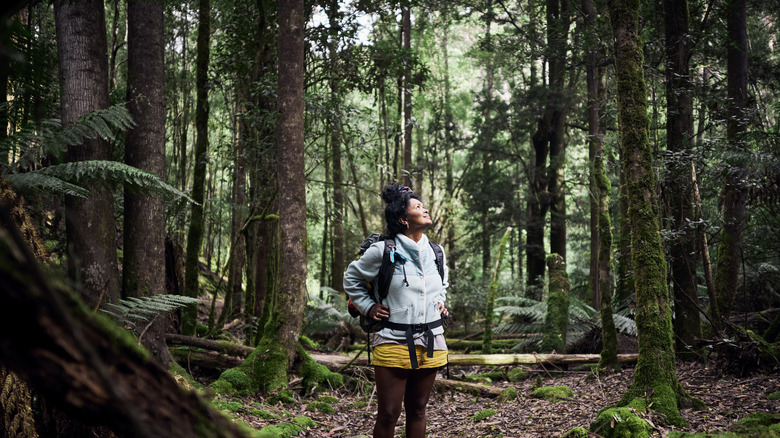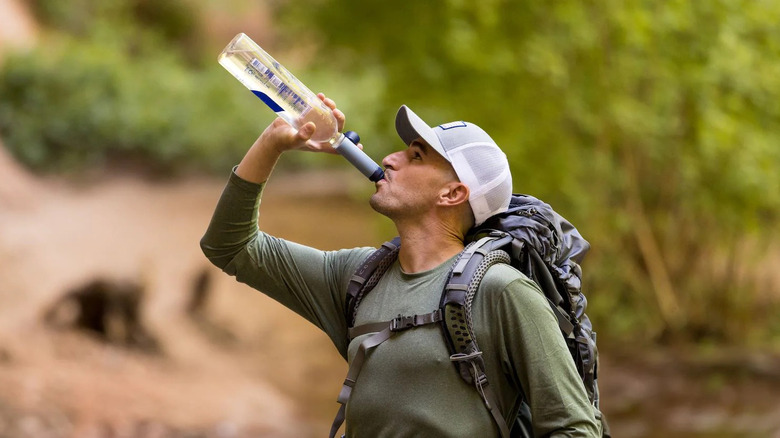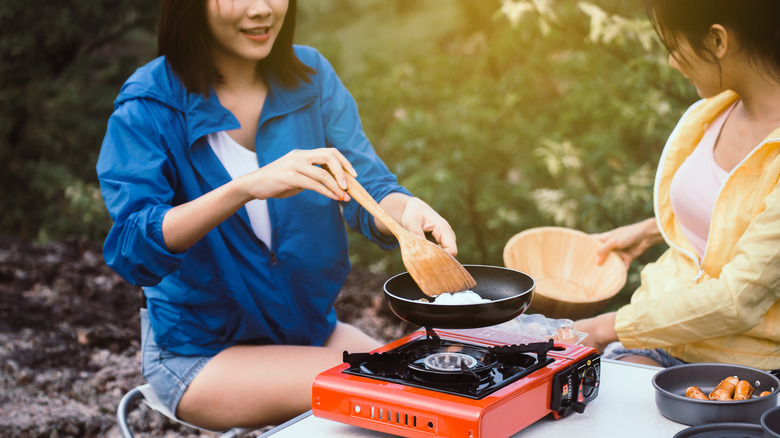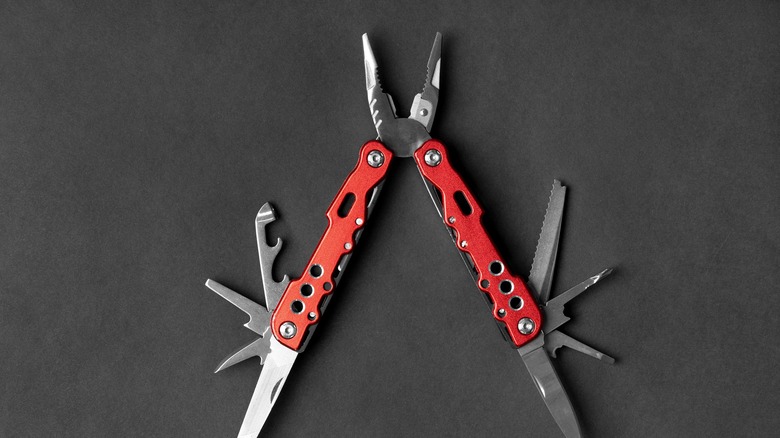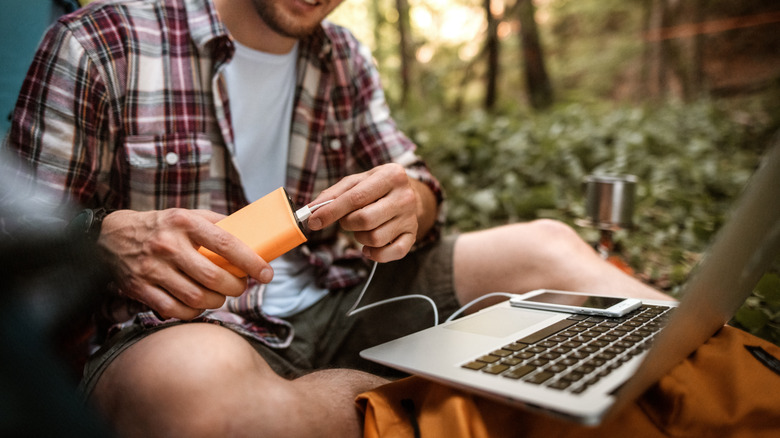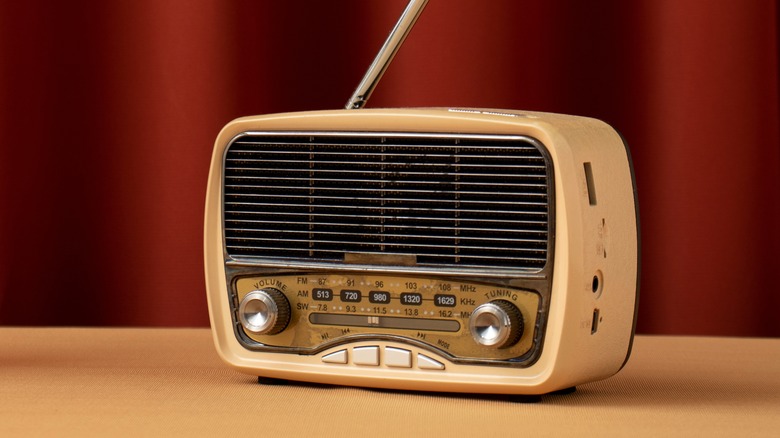6 Must-Have Safety Gadgets For Your Next Backing Trip
We may receive a commission on purchases made from links.
Backpacking off-grid can be a life-changing experience, especially because you can opt out of civilization temporarily and enjoy some peace and quiet. When done right, it can teach you more about yourself, build your resilience, bring you closer to nature, and open up your world. However, it can quickly turn horrifying if you're not prepared for the unexpected — especially if you're alone and don't have the right safety gadgets with you.
In general, backpacking invites its own sets of risks, such as isolation from medical services alongside the possibility of injury or an accident. In some cases, it can happen due to wild animals, not wearing the right clothes for the weather, sudden calamities like earthquakes, or even poor planning. Thankfully, your likelihood of dying due to wildlife, heat exposure, or cold exposure in national parks are pretty low, according to the National Park Service (via The Washington Post). However, this doesn't mean that you want to be part of the small percentage of people who get into trouble for overestimating your ability to survive in the wild.
These days, there are plenty of gadgets that you can add to your backpack, which can give you some added peace of mind no matter where your wandering feet take you. Whether it's to make sure you're well-hydrated, or that you continue to receive critical information in the middle of an expected storm, here are a few safety gadgets that you should definitely consider buying for your upcoming backpacking trip.
LifeStraw
Anyone who ever spent time in the wild will tell you that clean, potable water is one of the most important things for your health and safety. After all, an average person can only go up to three days without water. However, this number can severely decrease depending on your age, existing health conditions, and the environment.
Many backpackers will often carry some sort of single-use bottle or refillable water container during their camping trips, but you'll need to hydrate more often for several days of backpacking. Thankfully, the LifeStraw can help you sustain your water needs without adding too much to the weight of your bag, which matters for long-term trips.
Initially designed for humanitarian aid, LifeStraw is a water filter that can remove contaminants without the use of electricity. Although the LifeStraw Personal Filter ($19.95) isn't the most cost-effective on-the-go water filtration option, it has a lot of variants that are perfect for backpacking.
While its earlier designs required you to bend down and sip water through its body, its newer Peak series — including the LifeStraw Go Series ($49.95) bottle that has a built-in reusable container, and the LifeStraw Gravity Filter Systems ($65.95 for 3L) — lets you fill up multiple water containers, including your pet companion's bowl. That being said, the Life Straw isn't as useful if you're planning to camp in dry terrain, but it is perfect if you're camping near bodies of fresh or running water.
Portable Stove
The Centers for Disease Control and Prevention (CDC) warns that contaminated or untreated water could make you sick in more ways than one. From diarrhea to vomiting, waterborne pathogens like bacteria or viruses can cause havoc in your body. Thankfully, a portable stove can be useful for boiling water, which can help make it safe to consume by killing pathogens. To do this, the CDC recommends boiling water for one minute in a rolling boil before allowing it to cool for consumption.
While you can definitely use wood found near your campsite to create fire, it's not always the easiest or most environmentally viable option. Because of this, a portable stove can be a safer option. Portable stoves come in all shapes and sizes, but the best stoves for campers and backpackers are the light, efficient, and durable ones that you can rely on. Not only will you be able to boil water to drink, but you can also cook various dishes, such as soup, meat, pasta, hot pot, and more.
Although there are thousands of options out there, a lightweight (2.9 ounce) stove option that you should consider for your backpacking trip is the MSR PocketRocket Deluxe Canister Stove ($84.95), which has a 4.8 rating across 600 reviews on Amazon. Alternatively, if you suspect you'll be traversing through windy terrain, the SOTO WindMaster ($69.95) which weighs at only 2.3oz with its TriFlix pot support has a special design that acts like a windscreen.
Headlamp
While backpacking can feel amazing when you're exploring a new terrain with a bright sky, the same area can be scary in the dark. Unless you're trying to catch the first light on a sea of clouds at the peak of a mountain, you'll probably want to stay in your camp until the light comes back on.
In the past, people would create fires to get some light in the dark, where people would sit and get to know each other. However, if you're backpacking during the rainy season or in relatively wet places, you'll realize that creating fire with damp wood is a nightmare. It's also possible that your campsite does not have firewood available or doesn't allow people to burn wood to make a fire. Thankfully, you can use flashlights and headlamps to get light at night instead.
Headlamps are some of the best portable accessories that you should have with you when backpacking. While they function like flash lights, headlamps give you the added flexibility and free use of your hands. Weighing at only 1.87 ounces, the LHKNL Headlamp Flashlight ($24.99 for two) is a highly-rated option on Amazon, with an average rating of 4.5 stars across 17,000 reviews. With eight working modes that project up to 1200 Lumen of light for a maximum of 984.25 feet, it can also make it easier for rescuers to find you if ever you are caught in the dark in an emergency.
Multi-tool
Multi-tools are exactly what they sound like; an all-in-one gadget that can handle the job of several tools. While there are hundreds of variations for multi-tools out there, the best multitools for hiking and camping need to be lightweight and easily fit into your bag or hang from your belt. Some multi-tool features that backpackers should look for include scissors, a knife, wire cutters, a wood file, and a blade.
Some great options for multi-tools for backpackers include the Leatherman Skeletool ($74.95), which includes wire cutters, a knife, pliers, a bit driver, and a carabiner, which is useful for setting up camp, and weighs only 5 ounces. If you need more cutting prowess, the Leatherman Rebar ($79.95) also has a saw, two kinds of knives, and a metal/wood file. If you're okay with a little bit heavier, the Gerber Gear Suspension-NXT ($28.70) is a cheaper option with 15 tools at 6.4 ounces with a lifetime limited warranty.
With their lightweight, versatility, and overall usefulness, multi-tools can help you with your day-to-day camping needs or even save your life in the event of a backpacking emergency. These can be useful for everything from setting up camp, cooking your meals, and making fires, to opening packets.
Portable Charger
Aside from a communication device, your phone can also act as a flashlight, compass, and GPS. Depending on the phone you have and how long your hike is, the ideal portable charger model may vary. When choosing a power bank for backpacking, it's important to take into consideration the battery capacity of your mobile phone and make sure it can supplement it enough times for the duration of your trip.
One of the most powerful portable chargers you can bring backpacking is the Anker Prime Power Bank, which has fast charging capabilities and the ability to hold up to 20,000 mAh (or nearly six times the battery capacity of an iPhone 15). This means you can go up to a week with a fully charged mobile phone every day.
Not to mention, it can also be used to charge other electronic devices like computers and headphones, so you can even work while on the road or trail. Just take note that like all lithium-ion batteries, portable chargers will lose their ability to retain charge with time, so it is best to test yours out before every trip to avoid unexpected issues.
Radio
Among all the communication tools, radios are highly recommended camping must-haves for a reason. When you're in the middle of a backpacking trip, there's a chance that you'll still need information about the news, weather, or evacuation orders, which can happen if you're visiting a weather-prone area.
In an event where cell sites are damaged, your phone will not be able to act as your primary point of communication with the outside world, so you'll need a radio to get updates from signals further away. For this reason, we've also made a round-up of some of the best long-range radios and walkie-talkies that can help you during an emergency.
If you're planning to travel to an area with a lot of sunlight, you might also want to consider getting a solar-powered radio device. Not only is this more sustainable, but you can charge it while on the go. However, if you're likely going backpacking in an area with a lot of tree cover, a battery-powered or a hand-cranked one might also be a good bet.
On the other hand, for an all-around solution, you can use the RunningSnail Emergency Hand Crank Radio with LED Flashlight ($26.90), which you can charge via USB cable, hand crank, and the sun. Aside from the radio feature, it also has a 2000 mAh power bank and a flashlight.
